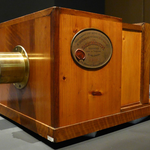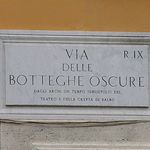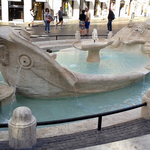Palazzo Senatorio
It is the seat of the Townhall of Rome. The palace was created by Giacomo della Porta and Girolamo Rainaldi in 1605 who readapted the previous project of Michelangelo replacing the asymmetrical medieval complex and the edifice of the XVth century on the ruins of the ancient Tabularium.
The façade with two side foreparts is divided by Corinthian pilaster strips. The first floor includes a portal and rich windows on the tympanum, richly decorated tombstones and coats of arms.
The second floor has the square windows under the entablature.
The superb "staircase" is imposing. It has two convergent ramps adorned by Roman statues.
Lying on the basement it made the palace very imposing. The basement was executed by Michelangelo between 1541 and 1554 (the first lower par on the right is the nineteenth-century addition). The stairs together with the lay-out of Marcus Aurelius is the only architectural work created by Michelangelo in life. Its front preceded by a wide basin has a niche in the middle with an ancient "seated statue of Minerva" of the Ist century with the porphyry garment on it. It was turned into "dea Roma". By sides the colossal lying figures of the "Nile" with the sfinx and the "Tevere" that were originally tigers (or wolves).
These statues of the IInd century came from the Constantine thermal bats of the Quirinal. From behind the balustrade together with statues crowning the building "Campanaria Tower" of Martino Longhi (1578-82) stands out with the watch in the middle and the ancient cross dressed in gilt blades.
In the bell tower there was the famous bell "Patarina". The Viterbesi took it away from Romans in 1200. It was ringing to announce the public events or the special occasions. Today even if it was replaced with the bell of the beginning of the years 800 it keeps on being called "Patarina" and it rings in case if the mayor of Rome is appointed.
The approach to the palace is from the "Sixtus IV entry" from where one can approach to the striking porch with two naves divided by pillars of the XIIIth century, which are spread under the Council Hall. Such Hall keeps the statue of Giulio Cesare of the I century A.C..That's why it is called Giulio Cesare Hall being the seat of the Court of the Senate. Nowadays it places the Municipal Council.
Next to it one can find the Hall of Flags or of Giunta with the flags of 14 Quarters of the Civic Guard of 1847. The table was made up in 1842 for the meetings of the Council and it is precious from the historical point of view. Now it is used for the purpose of the Capitolina Reunion.
The Red Hall, the yellow hall and the green hall are located nearby.
From the window of the Mayor's chamber the splendid panorama opens to Foro Romano.

 The records of Rome. Big numbers, not always enviable, for a big city.
The records of Rome. Big numbers, not always enviable, for a big city. New Phot-O-Matic section. To spend some time looking at photos (also) of Rome.
New Phot-O-Matic section. To spend some time looking at photos (also) of Rome. The administrative, urban, toponymic and imaginative subdivisions of Rome.
The administrative, urban, toponymic and imaginative subdivisions of Rome. Notice for tourists: in Rome you drink for free. Historical fountains and 'big noses'.
Notice for tourists: in Rome you drink for free. Historical fountains and 'big noses'. Free museums return on the first Sunday of the month.
Free museums return on the first Sunday of the month.